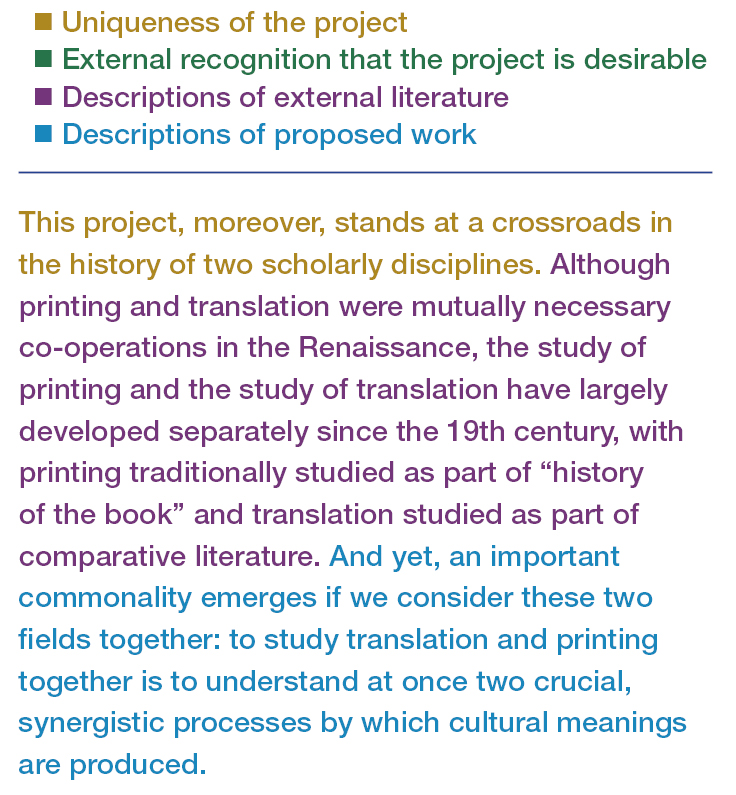First and Never
Case Study 4: Divided Literature (B)
People who write checks tend to only support projects that they believe will have a transformative impact. As part of the proposal submission process, you will often submit a CV, but the hope of review panels is that this project will be more than a line item on it. The goal is to find efforts that seem likely to transform the scholarly landscape. Because one fundamental feature of the scholarly landscape these days is fragmentation, it is not surprising that many grant proposals claim to conjure up this manner of transformation. It is a trend that applied to the previous case study and also this one.
![]()

 "This project...stands at a crossroads in the history of two scholarly disciplines,"
begins the excerpt. It is a bit less oppositional and critical than the previous.
Instead it is more an argument of elegant developments in two subfields which by their
nature belong together. "Although printing and translation were mutually necessary
co-operations in the Renaissance, the study of printing and the study of translation
have largely developed separately since the 19th century, with printing traditionally
studied as part of "history of the book" and translation studied as part of comparative
literature." Thus the current state of things is proposed to be a somewhat unnatural
state.
"This project...stands at a crossroads in the history of two scholarly disciplines,"
begins the excerpt. It is a bit less oppositional and critical than the previous.
Instead it is more an argument of elegant developments in two subfields which by their
nature belong together. "Although printing and translation were mutually necessary
co-operations in the Renaissance, the study of printing and the study of translation
have largely developed separately since the 19th century, with printing traditionally
studied as part of "history of the book" and translation studied as part of comparative
literature." Thus the current state of things is proposed to be a somewhat unnatural
state.
The author again takes up this argument of natural linkage at the end of the passage: "Printing and translation were, for both pragmatic and theoretical reasons, intimately linked as prime agents of a literary Renaissance--that is a fact of history. But it is one we have only begun to explore. For this reason, and because I see the two areas of scholarly inquiry (translation studies and the new history of the book) as theoretically linked, I shall consider them jointly in this large book project. (This pairing has already shown promise; see CV)."
To me the most interesting claim in there is embedded in the word "I." After repeated arguments for this natural linkage—"a fact of history"—the author interjects themselves. "...and because I see the two areas of scholarly inquiry...as theoretically linked, I shall consider them jointly in this large book project."
As with the previous two case studies, not only is an argument made about a certain blindness in the literature, but the author themselves—the proposed fellow—becomes part of the story. It is their vision, their multilingualism, their positioning outside of dominant legal historiography that enables the project. Most often, the final product is a book. And what is a book without its author?
Contact:
Nural Akchurin, Associate Dean for Research
College of Arts & Sciences
806.834.8838
nural.akchurin@ttu.edu
![]()
College of Arts & Sciences
-
Address
Texas Tech University, Box 41034, Lubbock, TX 79409-1034 -
Phone
806.742.3831 -
Email
arts-and-sciences@ttu.edu
